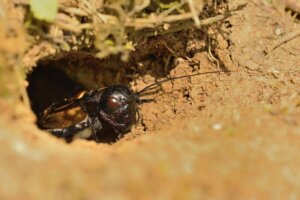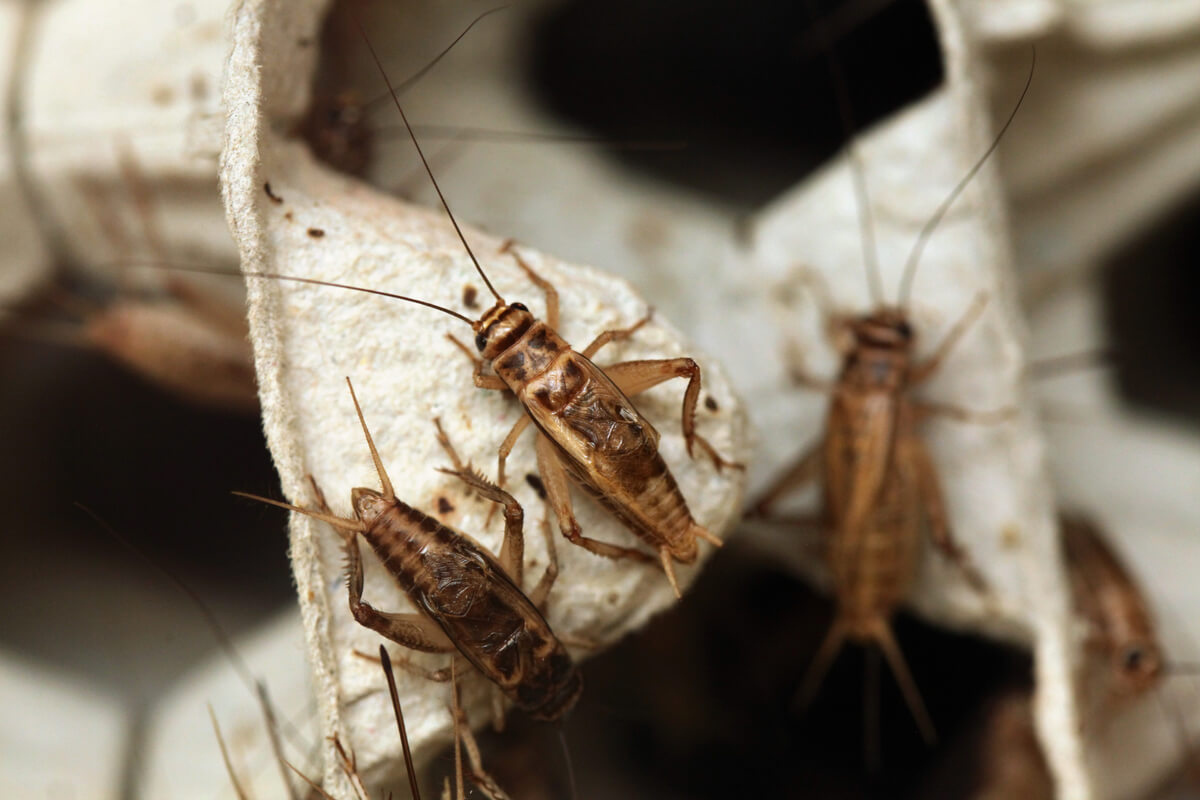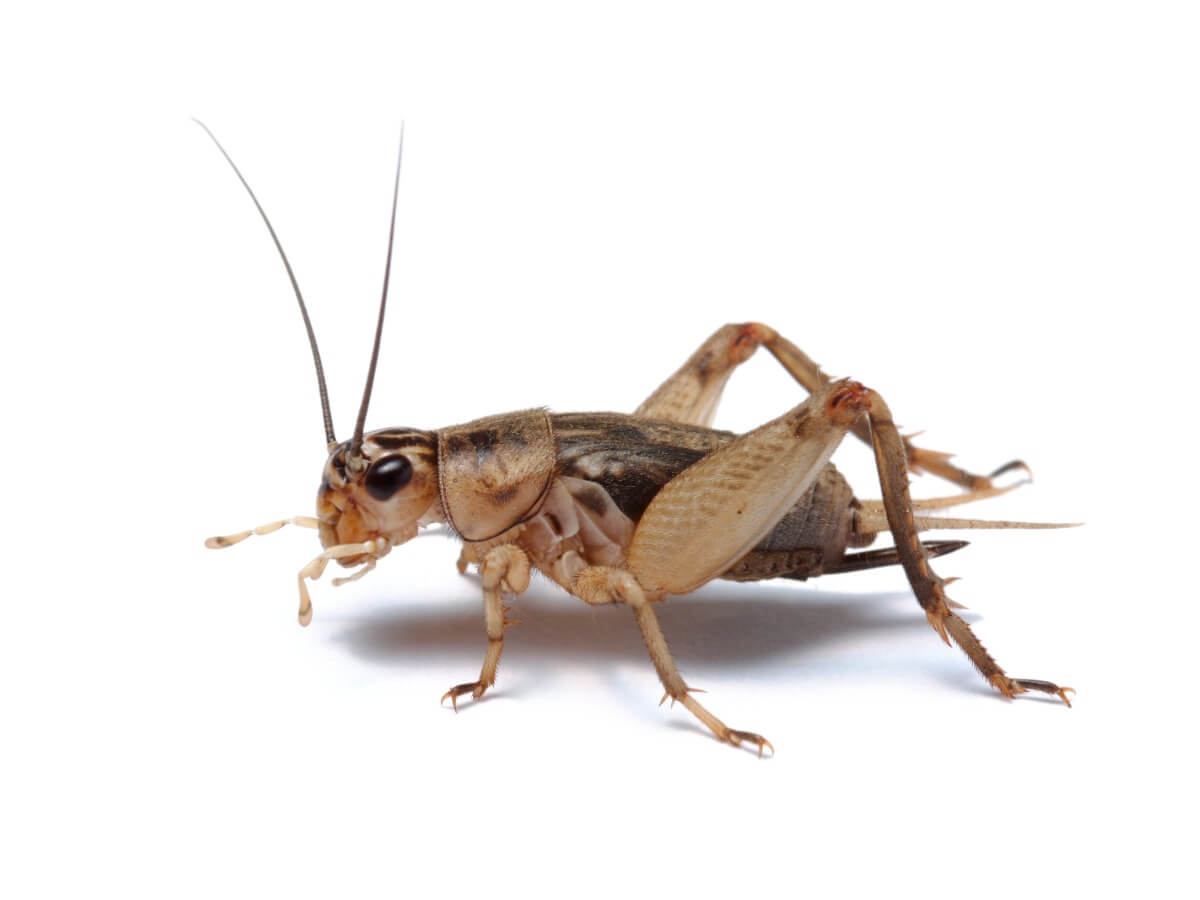What Do Crickets Eat?


Written and verified by the biologist Cesar Paul Gonzalez Gonzalez
Crickets are insects characterized by their excellent hopping ability and their distinguishable “song”. Nowadays, it has been observed that these invertebrates have a high protein content, so they’re considered a food suitable for humans. However, much of their nutritional value comes from what crickets eat themselves.
Specifically, the term “cricket” is used to refer to several species within the order Orthoptera. However, the following paragraphs will refer to the one most commonly used for cultivation and feeding, whose scientific name is Acheta domestica. Read on and learn more about what crickets eat.
What do crickets look like?
Crickets have a slender, cylindrical body segmented into three parts: head, thorax and abdomen. Unlike other insects, these invertebrates don’t show such noticeable divisions, so they actually appear to have only two segments. In addition, they have two pairs of wings that aren’t used for flying, but function as a musical instrument to make their typical sound (stridulation).
The head of these organisms is quite robust and houses its entire mouth structure towards the ground (hypognathous). Likewise, the thorax includes the 3 pairs of legs, of which only the first 2 are used for walking, and the last one is specialized for jumping. Unlike their relatives the grasshoppers, this species isn’t so much driven by jumping.
The distribution of these invertebrates is worldwide, because, thanks to their usefulness as live food for amphibians, birds, and reptiles they’ve reached other continents. In addition, due to their diet, they’ve been able to adapt to different environments, becoming the invasive orthopteran species par excellence.

Importance of the mouthparts
Insects are a group that boasts great diversity and different mouthparts. These structures are usually modified to adapt to the type of feeding of each species. In the particular case of Orthoptera, the mouth structure is of a chewing type, which allows them to crush different solid food.
The mouth of a cricket has 4 important parts: the labium, mandibles, maxillae, and labrum. The labrum and labium have an analogous function to the lips of mammals, as they serve to introduce food and to protect the oral region. On the other hand, the mandibles and maxillae function as the teeth of these organisms, since they’re in charge of crushing food.
What do crickets eat?
Crickets have an omnivorous diet thanks to their crushing mouth structure. In this way, they’re able to consume vegetation such as leaves, stems, fruits, and seeds and feed on various types of insects, including themselves (cannibalism). They choose food based on its availability, so they can also be considered opportunistic.
In addition, because many of these organisms have been distributed in urban areas, they’ve also adapted to consume the remains of human food. This gives them a great capacity to colonize new environments and this makes them successful in invading new regions.
What do crickets eat in captivity?
Due to the crickets’ great adaptability, it’s usually easy to keep them in captivity and breed them. To do this, they need a varied diet that sometimes includes commercial bird and rodent foods. However, these compounds mustn’t contain drugs or hormones, as they could cause problems in their development.
The best recommendation for the specimens to have a quality diet is to combine commercial feed with fruits, vegetables, and seeds. This will provide the necessary protein and water without incurring excessive expense for their breeding.
Additional recommendations
When you feed the specimens, separate the dry food from the wet food to prevent mold from forming in the rations you prepare for them. Also, if you choose to use pet pellets, remember that it’s best to crush them up a bit so they can eat them easily. Wash fruits and vegetables carefully, so that there are no traces of fertilizers or insecticides.
Although crickets can eat any type of waste, it’s best to devise a specific diet with fresh food for them. It isn’t usually necessary to give them extra water, as they obtain liquids from the vegetables they eat. However, in some cases, you can give them water in the form of a gel (which ensures hydration).
Remember to remove the food they don’t eat to prevent its decomposition, which can harm the crickets. Similarly, keep the hygiene to the maximum, as this will improve their quality and nutritional intake. One of the main reasons for keeping crickets is to use them as live food or as food, so it’s important to pay attention to these details.
Live food
Some animals (such as reptiles and amphibians) have diets based on eating insects, so it’s common to breed these insects to feed them. Crickets serve as a nutritious dish for captive organisms that can’t obtain their live food naturally.
Cricket farming takes advantage of two important factors: high nutritional value and low production cost. For this reason, in countries like Peru they’re used as an alternative for livestock feed.
Humans eating crickets
Strange as it may seem, the entomophagy or consumption of insects is a practice that has been around for a long time. However, due to the taboos that exist in today’s society, this activity is frowned upon by most people. This is contradictory, because the nutritional value of these invertebrates can be superior to that provided by the consumption of animal meat.
Orthoptera have between 62 and 75% of easily digestible protein and are quite abundant in various regions of the world. These insects are nutritious because they make great use of the food they metabolize, with an efficiency 5 times greater than that of cattle.
In short, crickets could be considered a healthy, nutritious and sustainable alternative for human food.

Whether your goal is to breed them to feed your pets or to cook a succulent dish for yourself, these insects have enormous nutritional potential. Despite their appearance, the benefits are impressive and don’t involve a complex breeding mechanism. Still, remember that the diet of crickets has an impact on their nutritional intake, so they’re only suitable if they’re well fed.
Crickets are insects characterized by their excellent hopping ability and their distinguishable “song”. Nowadays, it has been observed that these invertebrates have a high protein content, so they’re considered a food suitable for humans. However, much of their nutritional value comes from what crickets eat themselves.
Specifically, the term “cricket” is used to refer to several species within the order Orthoptera. However, the following paragraphs will refer to the one most commonly used for cultivation and feeding, whose scientific name is Acheta domestica. Read on and learn more about what crickets eat.
What do crickets look like?
Crickets have a slender, cylindrical body segmented into three parts: head, thorax and abdomen. Unlike other insects, these invertebrates don’t show such noticeable divisions, so they actually appear to have only two segments. In addition, they have two pairs of wings that aren’t used for flying, but function as a musical instrument to make their typical sound (stridulation).
The head of these organisms is quite robust and houses its entire mouth structure towards the ground (hypognathous). Likewise, the thorax includes the 3 pairs of legs, of which only the first 2 are used for walking, and the last one is specialized for jumping. Unlike their relatives the grasshoppers, this species isn’t so much driven by jumping.
The distribution of these invertebrates is worldwide, because, thanks to their usefulness as live food for amphibians, birds, and reptiles they’ve reached other continents. In addition, due to their diet, they’ve been able to adapt to different environments, becoming the invasive orthopteran species par excellence.

Importance of the mouthparts
Insects are a group that boasts great diversity and different mouthparts. These structures are usually modified to adapt to the type of feeding of each species. In the particular case of Orthoptera, the mouth structure is of a chewing type, which allows them to crush different solid food.
The mouth of a cricket has 4 important parts: the labium, mandibles, maxillae, and labrum. The labrum and labium have an analogous function to the lips of mammals, as they serve to introduce food and to protect the oral region. On the other hand, the mandibles and maxillae function as the teeth of these organisms, since they’re in charge of crushing food.
What do crickets eat?
Crickets have an omnivorous diet thanks to their crushing mouth structure. In this way, they’re able to consume vegetation such as leaves, stems, fruits, and seeds and feed on various types of insects, including themselves (cannibalism). They choose food based on its availability, so they can also be considered opportunistic.
In addition, because many of these organisms have been distributed in urban areas, they’ve also adapted to consume the remains of human food. This gives them a great capacity to colonize new environments and this makes them successful in invading new regions.
What do crickets eat in captivity?
Due to the crickets’ great adaptability, it’s usually easy to keep them in captivity and breed them. To do this, they need a varied diet that sometimes includes commercial bird and rodent foods. However, these compounds mustn’t contain drugs or hormones, as they could cause problems in their development.
The best recommendation for the specimens to have a quality diet is to combine commercial feed with fruits, vegetables, and seeds. This will provide the necessary protein and water without incurring excessive expense for their breeding.
Additional recommendations
When you feed the specimens, separate the dry food from the wet food to prevent mold from forming in the rations you prepare for them. Also, if you choose to use pet pellets, remember that it’s best to crush them up a bit so they can eat them easily. Wash fruits and vegetables carefully, so that there are no traces of fertilizers or insecticides.
Although crickets can eat any type of waste, it’s best to devise a specific diet with fresh food for them. It isn’t usually necessary to give them extra water, as they obtain liquids from the vegetables they eat. However, in some cases, you can give them water in the form of a gel (which ensures hydration).
Remember to remove the food they don’t eat to prevent its decomposition, which can harm the crickets. Similarly, keep the hygiene to the maximum, as this will improve their quality and nutritional intake. One of the main reasons for keeping crickets is to use them as live food or as food, so it’s important to pay attention to these details.
Live food
Some animals (such as reptiles and amphibians) have diets based on eating insects, so it’s common to breed these insects to feed them. Crickets serve as a nutritious dish for captive organisms that can’t obtain their live food naturally.
Cricket farming takes advantage of two important factors: high nutritional value and low production cost. For this reason, in countries like Peru they’re used as an alternative for livestock feed.
Humans eating crickets
Strange as it may seem, the entomophagy or consumption of insects is a practice that has been around for a long time. However, due to the taboos that exist in today’s society, this activity is frowned upon by most people. This is contradictory, because the nutritional value of these invertebrates can be superior to that provided by the consumption of animal meat.
Orthoptera have between 62 and 75% of easily digestible protein and are quite abundant in various regions of the world. These insects are nutritious because they make great use of the food they metabolize, with an efficiency 5 times greater than that of cattle.
In short, crickets could be considered a healthy, nutritious and sustainable alternative for human food.

Whether your goal is to breed them to feed your pets or to cook a succulent dish for yourself, these insects have enormous nutritional potential. Despite their appearance, the benefits are impressive and don’t involve a complex breeding mechanism. Still, remember that the diet of crickets has an impact on their nutritional intake, so they’re only suitable if they’re well fed.
All cited sources were thoroughly reviewed by our team to ensure their quality, reliability, currency, and validity. The bibliography of this article was considered reliable and of academic or scientific accuracy.
- Pijoan, M. (2001). El consumo de insectos, entre la necesidad y el placer gastronómico. Offarm: farmacia y sociedad, 20(9), 150-161.
- Patton, R. L. (1967). Oligidic diets for Acheta domesticus (Orthoptera: Gryllidae). Annals of the entomological society of America, 60(6), 1238-1242.
- Nosil, P. (2002). Food fights in house crickets, Acheta domesticus, and the effects of body size and hunger level. Canadian Journal of Zoology, 80(3), 409-417.
- Oloo, J. A., Ayieko, M., & Nyongesah, J. M. (2020). Acheta domesticus (Cricket) feed resources among smallholder farmers in Lake Victoria region of Kenya. Food science & nutrition, 8(1), 69-78.
- Apolo-Arévalo, L., & Lannacone, J. (2015). Crianza del grillo (Acheta domesticus) como fuente alternativa de proteínas para el consumo humano. Scientia, 17(17).
- Joern, A. (1979). Feeding patterns in grasshoppers (Orthoptera: Acrididae): factors influencing diet specialization. Oecologia, 38(3), 325-347.
This text is provided for informational purposes only and does not replace consultation with a professional. If in doubt, consult your specialist.








